Home/Threat

The Great Barrier Reef is in grave danger, and the twin perils brought by climate change, an increase in the temperature of the ocean and its acidity, if they continue to rise at the present rate the reefs will be gone within decades and that would be a global catastrophe.
— Sir David Attenborough Renowned British zoologist, naturalist and writer.

What’s happening?
Temperatures are rising on our land and in our oceans, caused primarily by an increase of carbon dioxide and other greenhouse gases. Carbon dioxide levels have been rising steadily for more than 100 years due mainly to the burning of fossil fuels, trapping more heat in our atmosphere and contributing to climate change.
The Great Barrier Reef is one of the richest and most complex natural ecosystems on the planet, but climate change is the biggest threat to the future of coral reefs here and around the world. It impacts reefs in a number of ways:
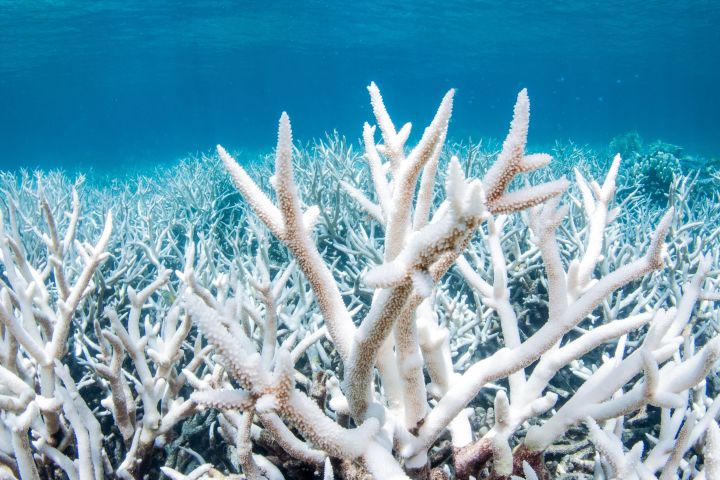
Coral bleach
Bleached corals expel their algal shells to reveal a bright white skeleton
When corals suffer heat stress, they expel the microscopic algae that live inside their tissues, revealing their white skeletons. Bleached corals are not dead, but are more at risk of starvation and disease.
Already marine heatwaves have triggered four mass coral bleaching events on the Great Barrier Reef in just seven years, reducing shallow water coral reefs by as much as 50%. Coral reefs can recover from bleaching over time, but only if temperatures drop and conditions return to normal.

Ocean acidificationOcean acidification formation process
The ocean absorbs carbon dioxide from the atmosphere, making it more acidic. This process is known as ocean acidification. Since the late 18th century, the ocean has absorbed about 30 percent of the carbon produced by humans, lowering its pH.
A more acidic ocean means that corals cannot build skeletons and form reefs, which help protect coastlines from storms and provide habitat for thousands of species of marine life.

Severe weather events
Climate change is increasing the frequency and intensity of severe weather events. Coastal regions like the Great Barrier Reef are particularly exposed to damaging cyclones, flooding and storms.
Between 2004 and 2018, 10 cyclones of category three or more crossed the Great Barrier Reef, causing significant damage to coral reefs.
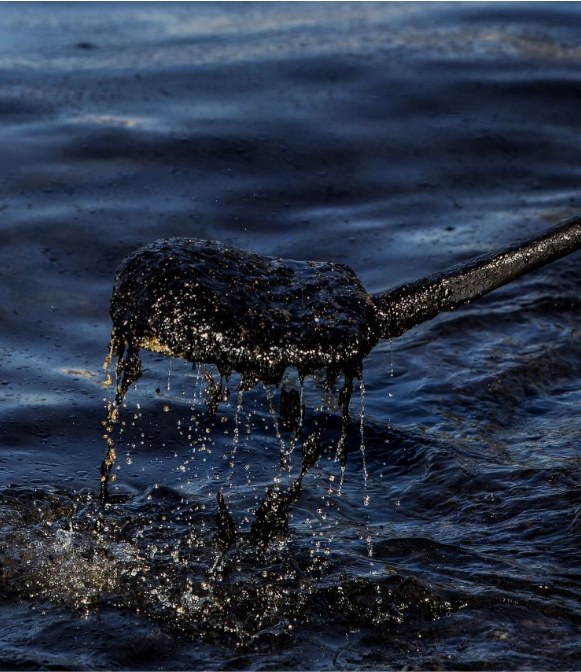
Habitat changes
As water temperatures rise, many marine species are being forced to move south to cooler habitats. This shift creates increased competition for food and shelter in cooler waters, threatening the entire ecosystem.
For Reef communities, the loss of marine life can have a devastating impact on local ecosystems, food sources and other industries such as tourism.
Tackling climate change
We have a once-in-a-generation opportunity to turn the tide on coral reef decline, but the window to act is closing.
To protect the Reef from climate change we must:
- Reduce emissions: Inadequate global action to address climate change is having a serious impact on the health of our Great Barrier Reef. Urgent global action is needed now to dramatically and rapidly reduce greenhouse gas emissions if we are to have any chance of saving our reefs. We must also strengthen key ecosystems such as seagrass meadows, mangroves and wetlands, which help absorb carbon dioxide from the atmosphere. These ecosystems play a key role in combating climate change by storing carbon. Coral reefs are among the most powerful blue carbon sites in the world.
- Help coral reefs adapt: Emission reduction alone is no longer enough to guarantee the survival of coral reefs. While the world works towards reducing greenhouse gas emissions, we must also help coral reefs adapt to the warmer temperatures already caused by climate change. We are doing this by developing and scaling up interventions that buy time for coral reefs. We’re concentrating on protecting corals from severe bleaching, helping them adapt to warmer temperatures and actively rebuilding resilient reefs where necessary.
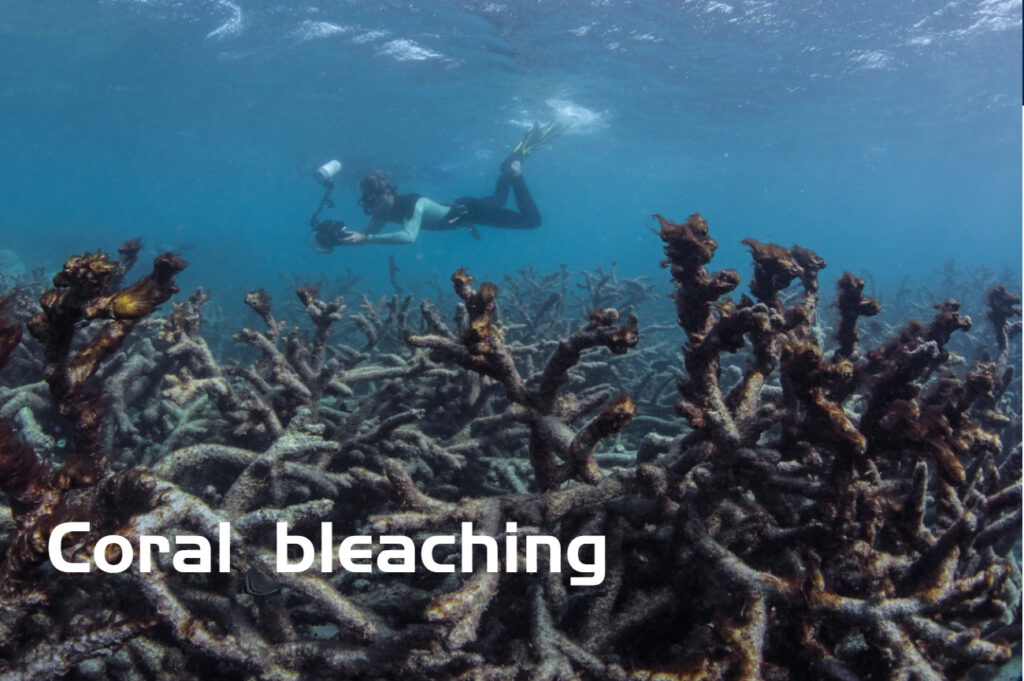
A diver swims through coral bleaching on the Great Barrier Reef in 2016.
Sourse: The Ocean Agency/XL Catlin Seaview Survey
What is coral bleaching?
Coral bleaching is the loss or reduction of symbiotic algae (zooxanthellae) within the coral beast, resulting in the coral turning white. The relationship between corals and symbiotic algae is reciprocal and symbiotic, with the coral providing the growing environment and nutrients and the symbiotic algae providing the coral with organic matter and oxygen needed for photosynthesis. When corals are stressed (e.g., increased temperature, pollution, acidification, etc.), the symbiotic algae within the coral beast are lost or reduced, and the coral consequently loses much of its color and turns white or lighter.
Facts about coral bleaching

Change in Sea Surface Temperature, 1901–2020
Data source: IPCC, 2013; NOAA, 2021
Rising ocean temperatures caused by climate change is the primary cause of coral bleaching.

Coral bleaching
Sourse: Great Barrier Reef Foundation
A temperature increase of just one degree Celsius for only four weeks can trigger bleaching.
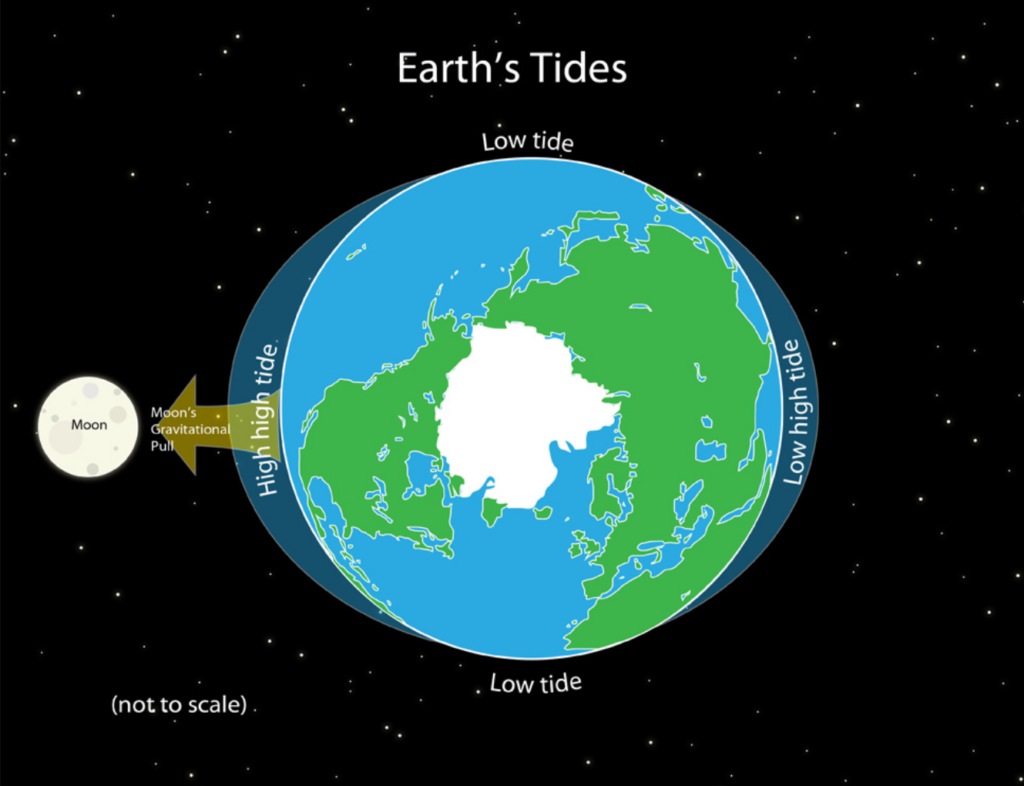
Earth’s Tides Effect
Sourse: Mary Crooks
During bleaching corals become transparent, revealing their white skeletons. Changes in water quality, increased sun exposure and extreme low tides can also cause corals to bleach.

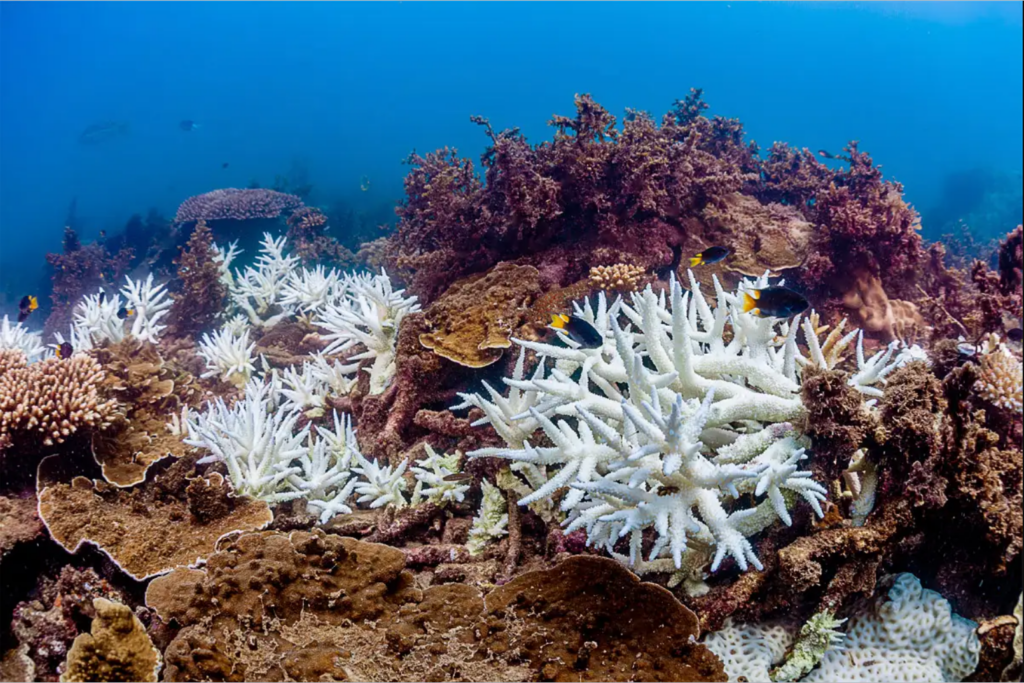
Mass bleaching events
The past two decades have seen several widespread coral bleaching events on our Great Barrier Reef, with four mass bleaching events in the last seven years.
2022
Coral bleaching was observed along the length of the Reef, with the Northern and Central regions experiencing extreme bleaching. In the South, bleaching was mostly minor. This mass bleaching event was particularly concerning because it occurred during a La Niña summer, which typically brings cooler, wetter conditions.
2020
Widespread severe bleaching was detected across many regions of the Great Barrier Reef. Of the 1,036 reefs surveyed from the air, 60% suffered moderate or severe bleaching. On-water monitoring capabilities were restricted due to the Covid-19 pandemic, so limited data on coral mortality was collected.
2017
The Reef experienced unprecedented back-to-back (2016 and 2017) bleaching, collectively affecting two-thirds of the Great Barrier Reef. The central third of the Great Barrier Reef was severely affected in early 2017, due to unusually warm sea surface temperature and accumulated heat stress. The southern sector was spared both years.
2016
In 2016, the Far Northern management area between Cape York and Port Douglas experienced widespread and severe bleaching due to record ocean temperatures. This led to record widespread coral bleaching on the Reef, with overall coral mortality at 22%. Bleaching in southern parts of the Reef was less severe.
What Should We Do?

Reduce greenhouse gas emissions
Coral bleaching is often caused by increased ocean temperatures, which is linked to climate change. Therefore, reducing greenhouse gas emissions is essential to prevent further damage to coral reefs.

Promote coral restoration
Coral restoration efforts can involve re-planting coral fragments or even creating artificial reefs to provide habitats for new coral growth.

Monitor coral health
Regular monitoring of coral health can help identify bleaching events and allow for prompt action to be taken to mitigate their effects.

Protect coral reefs
Protecting coral reefs from human activities such as overfishing, pollution, and physical damage can help reduce stress on coral and increase their resilience to bleaching.

Improve water quality
Reducing pollution and runoff from agricultural and industrial activities can improve water quality, which can in turn reduce stress on coral and increase their resilience to bleaching.

Support research
Supporting scientific research on coral bleaching can help advance our understanding of the causes and impacts of this phenomenon, as well as identify new ways to mitigate its effects. This can involve donating to organizations that fund research or advocating for increased funding for coral reef research.
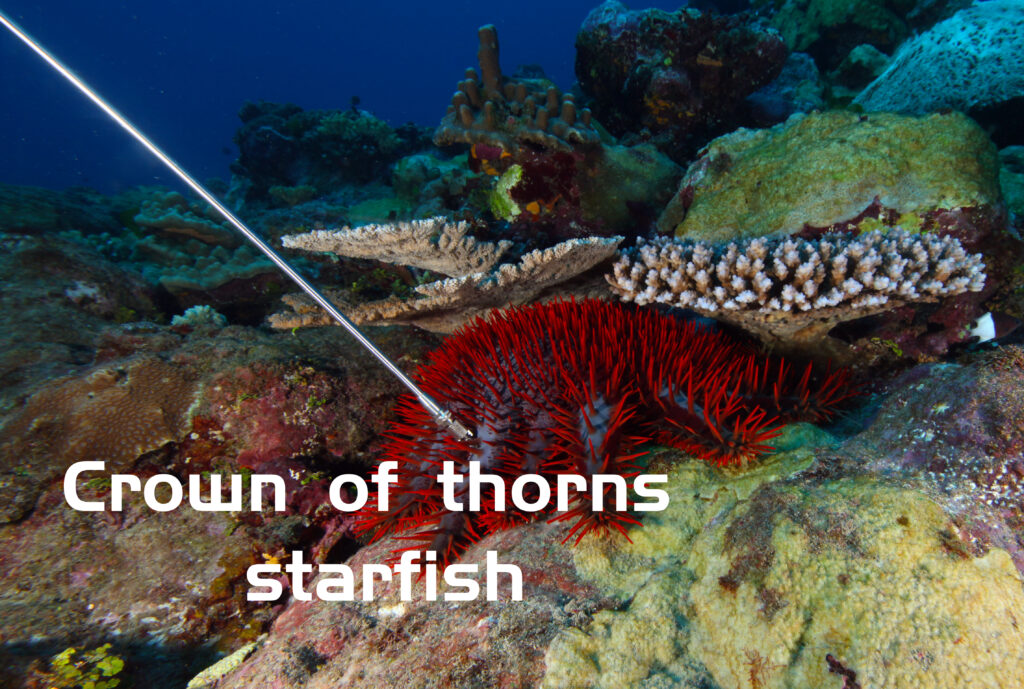
A close-up of a crown-of-thorns injection. To date, CRCP has supported partner efforts to remove more than 7,000 COTS around American Samoa.
Sourse: Greg McFall, NOAA Dive Program
Facts about crown-of-thorns starfish
Nocturnal by nature, COTS can move at speeds of up to 20 metres an hour.
COTS prey on nearly all corals and can eat their way through 10 square metres of it a year.
COTS are covered in spikes containing toxins that are venomous to both humans and marine creatures.
COTS are the world’s second largest starfish, reaching up to 1m.
COTS eat by extruding their stomachs out from their bodies, wrapping it around corals and digesting their tissues.
Like most starfish, if it loses one of its arms, a COTS can regrow a new one in around six months.
An adult crown-of-thorns starfish can live up to nine months without eating.
During an outbreak, which is when 15 or more COTS are found in a one hectare area, the starfish can strip a reef of 90% of its living coral tissue.
Why are COTS a problem?
In normal numbers on healthy coral reefs, COTS are an important part of the ecosystem. They tend to eat the faster growing corals which gives the slower growing species a chance to catch up, enhancing the coral diversity of our reefs. However, when the coral-eating starfish appear in outbreak proportions, the impact on coral reefs can be disastrous.
Crown-of-thorns starfish control
On the Great Barrier Reef, we reduce outbreaks using a targeted COTS control program, with trained divers injecting the starfish with bile salt (made in the liver of oxen) or vinegar. This kills the starfish but doesn’t harm the surrounding ecosystem.
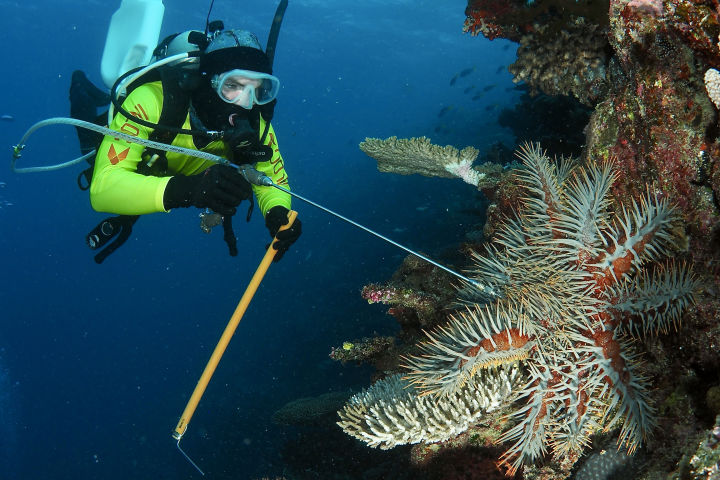

Dredging in Cairns, Great Barrier Reef
Resourse: Xanthe Rivett, CAFNEC, WWF
Land use
Agriculture
- Most land in the Great Barrier Reef catchment is used for grazing, crops, dairy and horticulture, with more than 80 per cent of the catchment supporting some form of agriculture.
- The most extensive land use is cattle grazing.
Mining
- Historically, extensive small-scale mining operations occurred through much of the Great Barrier Reef catchment.
- Production of saleable coal in Queensland has more than doubled since the early 1990s and the region is now associated with some of the world’s largest mines and coal ports.
- Curtis Island, located off the coast of the central Queensland city of Gladstone, is the site for the world’s first project converting coal seam gas to liquefied natural gas.
Urban and industrial development
- Urban and industrial development, excluding mining, in the Great Barrier Reef catchment is not extensive, however future economic projections suggest an increase in these types of land uses.
- Population growth in coastal areas is increasing the demand for infrastructure and services such as roads, water, sewerage and power.
- Although urban areas occupy only a small proportion of the catchment (less than 0.01 per cent), much of the development is located on floodplains and within the coastal zone.
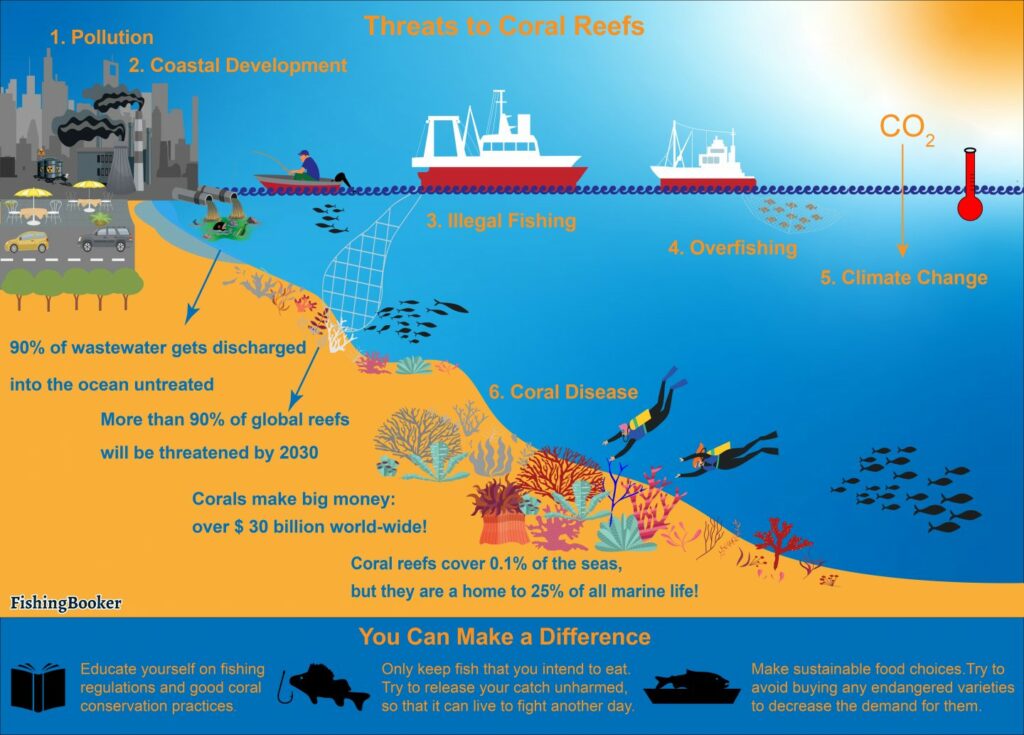
Sourse: FishingBooker
Port development
- Port development has been the major reason for coastal reclamation — infilling areas of ocean, wetlands or other water bodies — along the Great Barrier Reef coast.
- The total area reclaimed within the World Heritage Area since its listing in 1981 is approximately eight square kilometres. Most of this was in the Gladstone region.
- Port development can also create artificial barriers to freshwater flow, such as bund walls and infrastructure in waterways.
Aquaculture
- Land-based aquaculture operations — mainly prawns, barramundi, redclaw and freshwater fishes — are located close to the coast in parts of the southern half of the catchment.
- Over the past decade there has been little expansion of land-based aquaculture adjacent to the Great Barrier Reef region, however overall production has increased.
- There are no marine-based aquaculture operations within the region at present.
Island development
- Some Great Barrier Reef islands support residential areas and tourism resorts.
- The principal residential islands are Palm Island and Magnetic Island.
- Tourism resort developments exist on 27 Great Barrier Reef islands. Most are in the Whitsundays, including Hamilton, Hayman, Lindeman, South Molle and Long islands.
- A major redevelopment of Great Keppel Island resort was approved in 2013.
Impact
As Queensland continues to grow, so does development along the coast and islands adjacent to the Great Barrier Reef Region. Land in the Reef catchment area is used for agriculture, mining, urban and industrial development, port activities and island development. Reef health can be impacted not only by the legacy of past development actions — such as broad scale clearing for agriculture — but also by current and future actions, such as smaller scale clearing and reclamation for urban and industrial development.
Proudly powered by WordPress
Leave a Reply